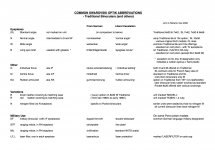Hi Sue,
As to what the letters mean, the short answer is: Not necessarily much!
Swarovski (like other manufacturers) uses letter combinations to distinguish their various product lines,
but as to how much insight that gives you as to the essential qualities of the various lines is debatable
In brief:
The NL is Swarovski’s newest line of roof prism binoculars introduced earlier this year
It is their current flagship model, and is most notable for the extra wide field of view, and unique ergonomics
Currently it's only available in medium size: with 42 mm diameter objectives
The EL was Swarovski’s previous flagship line. It's still available in small (x32 mm), medium (x42 mm) and large (x50 mm) sizes
It has a distinct 2 hinge open bridge design combined with centre focus, that was introduced by Swarovski
The SLC is also a high quality line, though with more conventional:
• external design, and
• curved field of view (verses the flat field of both the NL and EL)
It's available in both medium (x42 mm) and extra large (x56 mm) sizes
- - - -
The SF is Zeiss’ response to the Swarovski EL, with a wider field of view and a unique balance
It's available in x32 and x42 sizes
- - - -
For a better idea of what’s on offer from the premium manufacturers, I’d suggest starting with the Swarovski, Zeiss and Leica websites
Perhaps first download the catalogues so you can get an idea of who offers what, and so you can compare and contrast
Good luck on what should be an enjoyable journey
John
p.s. As to the 'official meaning' of the letters:
NL - New (or Nature?) Light
EL- Ergonomic (or Extra?) Light
SLC - Strong (or Shockproof?) Light Compact
and
SF - Smart Focus
For those interested in some history and detail of Swarovski's naming of various models see at:
https://www.birdforum.net/threads/what-are-the-german-words-for-el-slc.375599/






